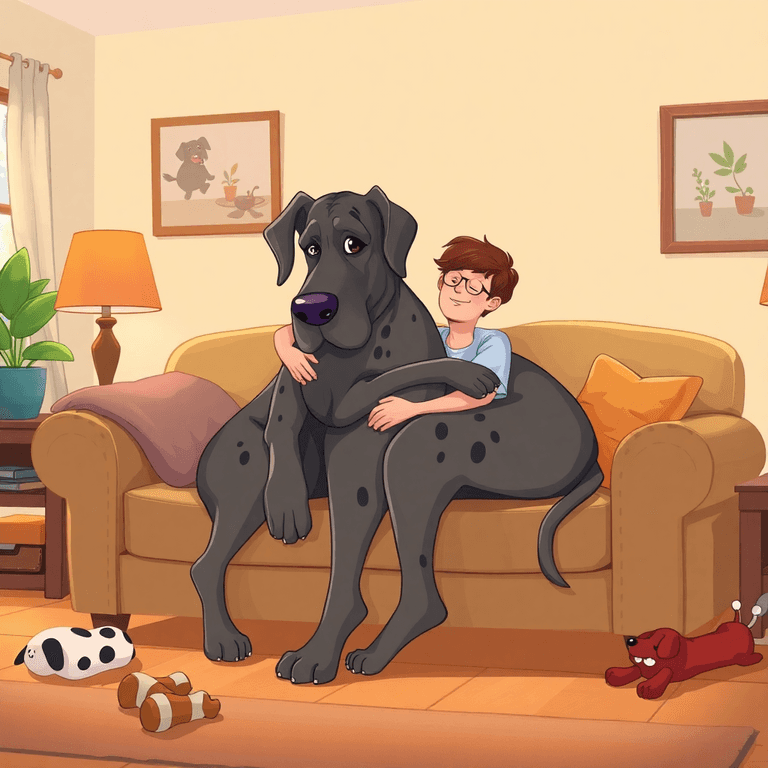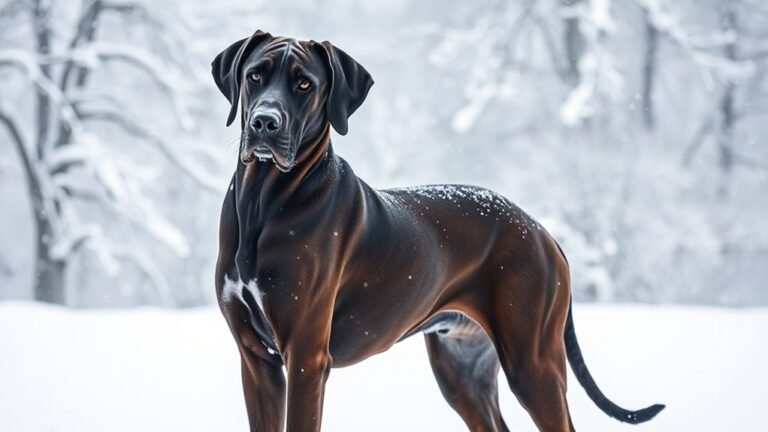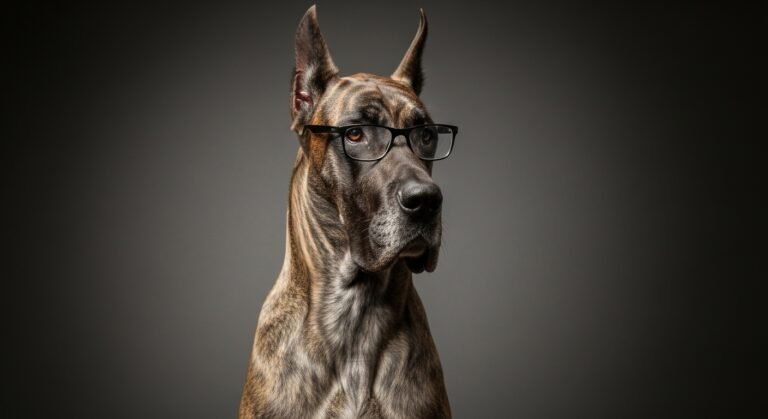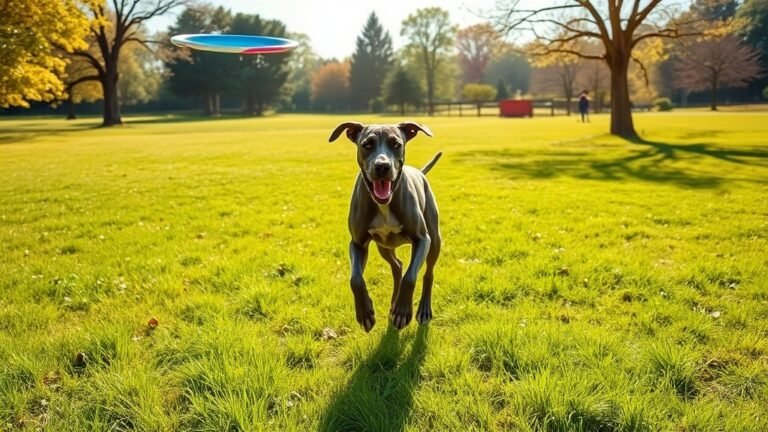Letting Go with Grace: A Great Dane’s Final Gift
When Is It Time to Euthanize Your Great Dane
When Is It Time to Say Goodbye to Your Great Dane
Woof! It’s me, your gentle giant, and I need to talk to you about something vital. I know this is tough to think about, but sometimes, we Great Danes need to help our humans understand when it might be time to let us go.
Look, I’ve lived a pretty awesome life being your couch-sized lap dog (sorry about your furniture, by the way). But here’s the thing – I’m getting older, and my body doesn’t work like it used to. My joints creak louder than your old recliner, and sometimes I can’t even get excited about dinner anymore. That’s when you know something’s wrong!
If I’m hurting all the time and those pain pills aren’t helping much, or if I can’t get up to greet you at the door anymore, that’s not the life I want. And if I stop wanting to eat my favorite treats or can’t breathe easily, well, that’s pretty serious stuff.
There’s this thing called the HHHHHMM Scale that helps figure out how I’m feeling day to day. It looks at whether I’m happy, hungry, and comfortable. Your vet can explain it better than I can – I’m just a dog who’s good at stealing food off counters.
The most important thing? Don’t feel guilty. You’ve given me the best life a giant goofball like me could ask for. When the time comes, helping me cross that rainbow bridge peacefully is the last great gift you can give me. Trust your vet, trust your heart, and remember all our happy times together.
Now, can we talk about something more fun? Like how I deserve another treat right now?
Understanding Great Dane Lifespan and Age-Related Health Decline
Hey there, humans! It’s me, your gentle giant Great Dane, and I need to have a chat with you about getting older. Trust me, when you’re my size, everything happens in extra-large!
So here’s the deal – us Great Danes start feeling like senior citizens when we hit 6 to 8 years old. I know, I know, that seems pretty young to you humans who live forever. Time moves faster when you’re this magnificent.
As I get older, my body starts playing some not-so-fun tricks on me. My joints get creaky like an old wooden ship, my heart works harder than it used to, and sometimes my tummy gets all twisted up (which is super scary, by the way). It’s essential to be aware of common health challenges like hip dysplasia that can arise as I age.
Oh, and occasionally I forget where I put my favorite tennis ball or why I walked into the kitchen. Sound familiar?
You might notice I’m not bouncing around like a giant puppy anymore. Those stairs look like Mount Everest now, and sometimes I huff and puff like I just ran a marathon when all I did was walk to my food bowl.
I might also act a little differently – maybe I’m more clingy or confused about things that used to be easy.
The good news is you can help me age gracefully! Keep taking me to the vet for check-ups, help me with my aches and pains, and maybe we can take shorter, slower walks instead of those crazy long hikes.
Help me stay happy in my golden years with regular vet visits, joint care, and gentle adventures that match my slower pace!
Just remember – I’m still your loveable goofball, just in a slightly creakier package!
Recognizing Critical Health Conditions That Signal End-of-Life Decisions
So here’s the deal: sometimes, us gentle giants face some pretty scary health problems that might mean it’s time for you to make some tough choices about our care. I know, I know – nobody wants to think about this stuff, but stick with me here.
First up, there’s this thing called bloat (or if you want to get fancy, gastric dilatation-volvulus). My stomach can get twisted up like a pretzel, and let me tell you, it’s about as fun as it sounds – which is to say, not at all! This happens super fast and can be dangerous, even with the best medical care. Approximately 43 out of 100 Great Danes experience it in their lifetime, so you gotta be vigilant!
Then there are heart problems that can hit us hard and suddenly. My big heart isn’t just for loving you – it’s big, and sometimes that causes issues. When severe heart events happen, they can be life-threatening emergencies that don’t always get better with treatment.
Don’t even get me started on brain problems that can pop up out of nowhere. These neurological crises can mess with how I think and move around.
But it’s not just the sudden scary stuff. Some of us deal with long-term illnesses that get worse over time. Bone cancer (osteosarcoma) is unfortunately pretty common in us tall dogs, and it can be incredibly painful.
Heart disease can also progress slowly, making it harder for me to breathe and play. And my poor joints? Well, let’s say carrying around all this awesomeness can wear them down, making it challenging to get around even with medicine.
The bottom line is this: when these conditions get terrible and the treatments aren’t helping me feel better anymore, that’s when you humans have to think about what’s best for me. I trust you to know when my quality of life isn’t what it should be.
Life-Threatening Emergency Conditions
Woof! Hi there, humans! It’s me, your friendly neighborhood Great Dane, and I need to tell you about some scary stuff that can happen to us big dogs. Don’t worry – I’ll try to keep it light even though this is serious business!
So picture this: I’m living my best giant dog life, then BAM! Sometimes we Great Danes can get into real trouble fast. The biggest scary thing for us? It’s called bloat, but it’s way worse than when you eat too much pizza. My stomach can twist around and fill up with gas like a balloon. Yikes! If this happens, my humans have to rush me to the vet super quickly or I’m in big trouble.
Other not-fun emergencies include getting hurt badly, bleeding inside where you can’t see it, or my big heart deciding to take an unscheduled break. If any of these happen, I might breathe funny, my gums turn white instead of pink, I might fall over, or act upset and scared. My humans need to keep an eye out for emergency signs to ensure they recognize when it’s time for a vet visit.
Here’s the tricky part that makes my humans cry: sometimes even the vets can’t fix me, and trying might make me hurt more. When that happens, my family might decide to help me go to sleep forever so I don’t have to be in pain.
It’s sad, but it’s also really loving. They put my comfort first, which is what good dog parents do.
Progressive Chronic Disease Signs
When My Body Starts Giving Me Trouble Over Time
Hey there, friends! So we’ve talked about those scary emergencies that happen fast, but now I need to tell you about something different – when my body starts having problems that get worse slowly over time. These aren’t the “rush to the vet right now” kind of problems. These are the sneaky ones that show up gradually over weeks, months, or even years.
The tricky thing about these slow-moving health issues is that my humans have to keep watching how I’m feeling as things get worse, even when the vet is doing everything possible to help me feel better.
Let me tell you about some of the big ones that us Great Danes might face:
| What’s Wrong With Me | How It Starts | When It Gets Bad |
|---|---|---|
| My Heart Gets Big and Weak | I get tired easily during walks, and I cough sometimes | I can barely breathe, and I might fall down |
| Bone Cancer (Ouch!) | My leg hurts a little, and it may look puffy | The pain is terrible, and I might break bones |
| My Kidneys Stop Working Right | I’m always thirsty and need to pee ALL the time | I throw up, feel confused, and might have seizures |
| My Brain and Nerves Act Up | I’m a little clumsy, bumping into things | I can’t walk, or might not be able to eat |
With these long-lasting problems, my family has to keep checking: Am I hurting? Can I still get around okay? Do I still love my dinner? Am I still acting like the dignified Great Dane I am, or am I losing that too? They need to be aware of dilated cardiomyopathy as a common heart issue in Great Danes.
It’s not easy, but knowing what to watch for helps my humans take the best care of me possible.
Assessing Your Great Dane’s Quality of Life Using Objective Criteria
Look, I know you get all emotional when you’re worried about me – trust me, I can smell those feelings from a mile away with this super sniffer of mine! But here’s the thing: you can’t just go by your tears and worry when deciding if I’m still happy being your couch-sized lapdog.
You need to look at the real stuff that matters to us, Great Danes. Can I still wobble my way to my food bowl without looking like a newborn giraffe? Am I still excited when you open that magical can that makes the beautiful “pop” sound? Can I manage my basic dog duties without too much trouble?
And please, PLEASE pay attention to whether I’m hurting. I’m pretty good at hiding pain because, well, I’m a tough guy in a huge package. But those smart vet people have created special ways to figure out if I’m uncomfortable, even when I’m trying to be brave. You should also be aware of behavioral signs of distress that indicate I might be feeling upset or unwell.
These special measurement tools that the dog doctors made aren’t just fancy paperwork – they’re like report cards for how well I’m doing each day. They help you see past your worried parent feelings and look at the real facts about whether your supersized buddy is still enjoying life or if it might be time for that final act of love.
Daily Function Assessment Tools
How My Humans Figure Out If I’m Having a Good Day
Hi there! I’m a Great Dane, and I’ve noticed my humans have some pretty clever ways of checking if I’m doing okay. They can’t just ask me, “Hey, how are you feeling today?” (though I wish they could!), so they’ve come up with these neat report cards for dogs like me.
My humans use something called the HHHHHMM Scale. Sounds like they’re humming. But it’s checking seven critical things about my day. They look at whether I’m hurting anywhere, if I’m eating my kibble like usual, drinking enough water, keeping myself clean, wagging my tail and seeming happy, walking around okay, and whether I’m having more awesome days than crummy ones.
There’s also this other checklist called JOURNEYS that sounds like we’re going on a road trip! It checks if I can still jump up on the couch (even though I’m not supposed to), how I do on walks around the neighborhood, if my bathroom business is regular, whether I still play with my squeaky toys, if I’m chowing down at dinner time, how much I enjoy belly rubs and games, and if I still love hanging out with my family and doggy friends.
The coolest part is that my humans give me scores on all these things, kind of like grades in school. They write down how I’m doing each week, which helps them see if I’m getting better or if something’s bothering me.
It’s pretty clever because sometimes my humans get so worried about me that they might think I’m worse than I am, or they love me so much they don’t want to see when I’m struggling.
These report cards help them make the best decisions for me without their feelings getting in the way too much! Proper care can help many Great Danes live beyond the average lifespan, so they want to ensure I’m happy and healthy.
Pain Level Evaluation
Look, I wish I could just walk up to you and say, “My hip is killing me today!” But since I can’t use words like you do, I’ve to show you in other ways. And trust me, I’m pretty good at giving hints if you know what to look for!
First off, watch how I move around. If I’m walking like I’m 100 years old or acting like those stairs are Mount Everest, something’s probably bothering me. When my joints hurt, I might skip my usual happy dance when you come home or avoid jumping on the couch for our Netflix sessions.
My appetite is another big clue. I’m a Great Dane – I LOVE food! So if I’m turning my nose up at dinner or just picking at my kibble, that’s your red flag right there. Pain makes everything less fun, including my favorite meal times.
You might also notice I’m breathing differently. Not the normal panting after chasing squirrels, but weird heavy breathing when I’m just lying around. Sometimes I might whimper or make little groaning sounds, especially when I’m trying to get comfortable.
Please pay attention to how I position my body, too. If I’m hunched over like I’m protecting my belly, or if I keep my head down low, or if I’m shaking when it’s not cold outside, I’m probably hurting somewhere.
Here’s something that might surprise you – I might get snappy or grumpy when I usually wouldn’t. It’s not that I don’t love you anymore, it’s just that pain makes everyone cranky!
The smart thing to do is write down what you notice. Please keep track of when I seem uncomfortable and how bad it looks. Your vet has special charts to help figure out how much pain I might be feeling. Additionally, early diagnosis is crucial for effective treatment and can significantly impact my quality of life.
The most important thing? Don’t ignore these signs. I depend on you to be my voice when something hurts. You know me better than anyone, so trust your gut when something seems off. I want to enjoy every belly rub and treat you give me, but I need your help to feel my best!
Veterinary Quality Metrics
My humans discovered this cool thing called the HHHHHMM Quality of Life Scale – and let me tell you, I’d no idea I was being graded!
The vets have figured out a way to score how well us Great Danes are doing without just guessing. They look at stuff like how well I can chase squirrels (mobility), whether I still drool over dinner time (appetite), if I smell like a rose or a garbage truck (hygiene), and how much my tail wags (happiness).
The whole thing works with numbers, which is perfect because my humans love their spreadsheets almost as much as they love me. My vet helps fill out this report card during my check-ups, making sure my humans aren’t just thinking with their hearts – though let’s be honest, their hearts are pretty smart when it comes to me.
What’s neat is that these scores give everyone the straight facts instead of my humans worrying themselves into a tizzy over every little thing. Additionally, early socialization is crucial for helping us Great Danes adapt to various situations and environments as we age.
When the numbers start dropping and don’t bounce back even with the best treats and belly rubs, it helps everyone understand what might be best for me. It’s like having a translator between dog feelings and human understanding.
Working With Your Veterinarian to Evaluate Treatment Options and Prognosis
Working With My Vet to Figure Out What’s Next
Hey there! So when I’m not feeling so great and my humans are getting that worried look in their eyes, it’s time for me and my family to have a serious chat with my vet.
Don’t worry though – my vet is pretty cool and always gives me treats (even when I’m not feeling my best).
My vet is awesome and sneaks me yummy treats even when I’m having my not-so-good days.
Here’s what my vet looks at to see how I’m doing:
- Those weird picture machines that go “buzz” – They show if anything yucky is spreading around in my chest. I have to lie still, which is pretty easy since I’m tired a lot these days.
- The “ouch scale” – My vet watches how I walk and checks if I’m still hurting even with all my medicines. I try to be brave, but sometimes my humans can tell when things break.
- The walking test – This one’s tough because I used to bound around like a puppy, but now my legs don’t always want to cooperate. My vet watches to see if I can still get around okay.
- Checking if my medicines are working – Sometimes the pills that used to help me feel better don’t work as well anymore. It’s like when your favorite toy stops squeaking.
My vet talks to my humans about all sorts of options – some to help me feel more comfortable and others that are more intense.
The best part is that everyone just wants me to be happy and feel good, which honestly makes my tail wag even when I’m having a rough day.
Navigating the Emotional and Ethical Aspects of Euthanasia Decisions
Look, I know you love me more than treats (and that’s saying A LOT), but sometimes us big dogs face tough times when our bodies don’t work like they used to. When the vet gives you all that medical information about my health, I can see those worried looks on your faces. I get it – this stuff is tough to think about.
Here’s the thing, though – I trust you to make the best choice for me, even when it’s the hardest choice ever. I know you might feel torn between wanting to keep me around forever and wanting me to feel good. That’s normal! Even us dogs have complicated feelings sometimes.
If you’re struggling with these big decisions, it’s okay to ask for help. Some people understand precisely what you’re going through – counselors, support groups, and special helpers at the vet’s office. They’re like emotional treat dispensers for humans!
The most important thing I want you to know is this: don’t feel bad about putting my comfort first, even if it means saying goodbye sooner than you want. I’d rather have my dignity and your love than stick around when I’m hurting just because you can’t imagine life without my slobbery kisses.
You’re good humans, and whatever you decide, I know it comes from your heart.
Preventive Care Strategies to Extend Your Great Dane’s Healthy Years
How I Stay Healthy and Happy as a Great Dane
- My exercise routine is just right – I love my daily walks and playtime, but my humans are intelligent about not making me do crazy jumping or running on hard surfaces. My joints are still growing (even though I’m already huge!), so we stick to gentle activities that keep my heart pumping without hurting my legs.
- I eat special big-dog food – My kibble isn’t just any old dog food. It’s made just for giants like me! This special formula helps me grow at the right speed so my bones develop properly. No need to rush – I’m already going to be enormous anyway!
- The vet checks my heart regularly – Great Danes like me can have heart problems, so my vet listens to my ticker during checkups. Catching any issues early means I can get help before I even feel sick. Pretty clever, right?
- I watch my waistline – Even though I’m naturally big, my humans make sure I don’t get chubby. Extra weight is tough on my joints and organs, and nobody wants a couch potato Great Dane!
These simple steps help me live my best doggy life and avoid the health problems that might cut my adventures short.
After all, the world needs more gentle giants like me around!
Final Thoughts
Hey there, humans! It’s me, your friendly neighborhood Great Dane, and we need to have a chat about something pretty serious – but don’t worry, I’ll try to keep things light with my natural doggy charm.
So here’s the deal: I know you love me to pieces (and trust me, the feeling is mutual – you’re the best human a giant goofball like me could ask for!). But sometimes, we dogs need our humans to make some tough decisions for us. I’m talking about knowing when it might be time to say goodbye.
I’ve heard that about 4 out of 10 dog parents wait too long to make this call because they can’t bear to let go. I get it – I mean, look at this adorable face! But here’s the thing: if I’m really hurting and can’t enjoy my favorite things anymore – like stealing your socks, knocking things over with my tail, or giving you those famous Great Dane hugs – then keeping me around just because you’ll miss me isn’t fair to me.
What you humans need to do is look at how I’m doing day to day. Can I still wag my tail when I see you? Do I get excited about dinner time? Can I walk around without looking like I’m in pain? If the answer is no to most of these things, even after the vet tries to help me feel better, then maybe it’s time to think about letting me go peacefully.
When it is my time, I ask that you be the last face and one last belly rub I see before I go to sleep. Think of all the great times we had, and I will be waiting for you at the Rainbow Bridge.
The best thing you can do is work with my vet to figure out what’s best for me. And hey, if you take good care of me with regular checkups and catch problems early, we might have many more years of me accidentally sitting on you!
In Memory of Zoe- May/2016-July 11/2025 ( Our First Great Dane)
You may be gone, but we will never forget you




